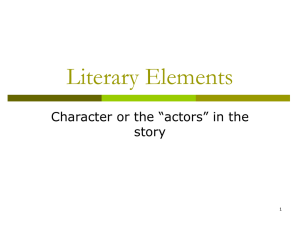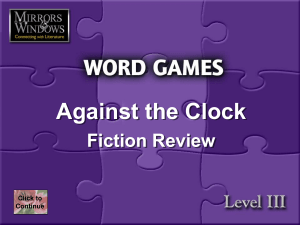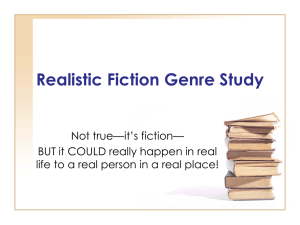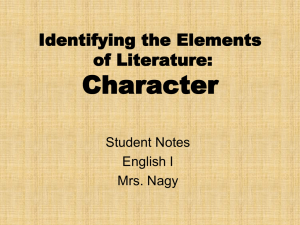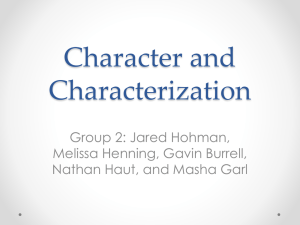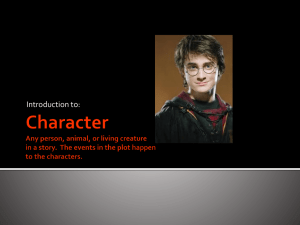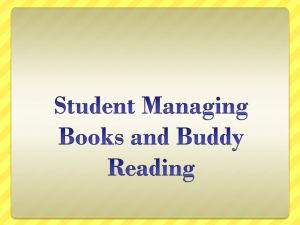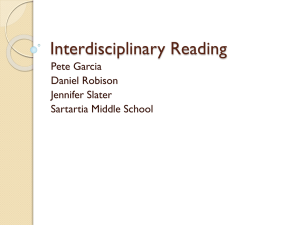Character
advertisement
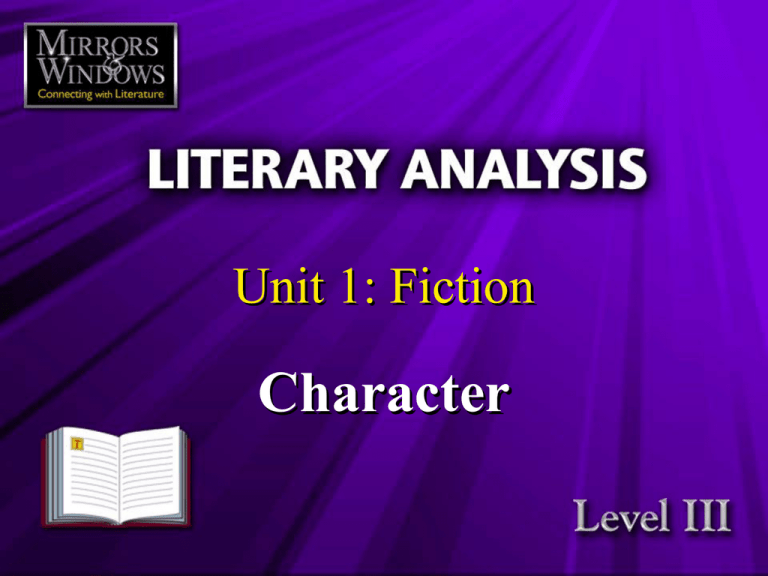
Unit 1: Fiction Character Fiction is like a spider’s web, attached ever so lightly perhaps, but still attached to life at all four corners. —Virginia Woolf <skip intro> What is fiction? • Fiction is a category of literature that includes any work of prose that tells an invented or imaginary story. What are the two main forms of fiction? • The two main forms of fiction are the short story and the novel. What are your favorite types of fiction? • • • • • • • • Realistic fiction Science fiction Fantasy Horror Historical fiction Sports fiction Mystery Westerns What are the purposes of fiction? • • • • To entertain readers To show readers new and different ideas To provide readers with an escape from reality To teach readers to be understanding and sympathetic • To help readers explore unknown worlds What are the five elements of fiction? • • • • • Plot Point of view Characters Setting Theme Characters • Characters are imaginary people or animals who take part in the action of a literary work. I have tried every device I know to breathe life into my characters, for there is little in fiction more rewarding than to see real people interact on a page. —James A. Michener What do you think makes fictional characters seem like real people? What makes a character memorable? Characterization • The act of creating or describing a character is called characterization. • Writers use three major techniques to form a character: – Showing what characters say, do, or think – Showing what other characters (and the narrator) say or think about them – Describing what physical features, dress, and personality the characters display Characterization • In this excerpt, readers get to know Gary by what he says and does. I leaned forward and said, “Well, I think we have lots of talent.” Oh? like who, for example? she said. I said, “Well, I could do something.” You? she said. “Or I could get together with some other kids and we could do a skit.” Like what? she said. I said, “Oh, I don’t know. Something about the school burning down. It all depends.” “That doesn’t sound funny to me,” she said. Marcy didn’t think it was funny either. What burned my toast was her saying “You?” when I volunteered to be in her talent show. I was only being helpful… —from “Gary Keillor,” by Garrison Keillor Characterization • In this excerpt, readers learn about Joby by what the narrator says about him. …At midnight a peach stone…struck once, like panic, which jerked the boy upright. In silence he listened to his own heart ruffle away, away, at last gone from his ears and back in his chest again. …he turned the drum on its side, where its great lunar face peered at him whenever he opened his eyes. His face, alert or at rest, was solemn. It was indeed a solemn time and a solemn night for a boy just turned fourteen in the peach field near the Owl Creek not far from the church at Shiloh. —from “The Drummer Boy of Shiloh,” by Ray Bradbury Characterization • In this excerpt, readers get to know Lemon Brown based on the description of his physical appearance. The person who called himself Lemon Brown peered forward, and Greg could see him clearly. He was an old man. His black, heavily wrinkled face was surrounded by a halo of crinkly white hair and whiskers that seemed to separate his head from the layers of dirty coats piled on his smallish frame. His pants were bagged to the knee, where they were met with rags that went down to the old shoes. The rags were held on with strings, and there was a rope around his middle. —from “The Treasure of Lemon Brown,” by Walter Dean Myers Motivation Characterization is the presentation of the nature of the people in a story. Characterization is really the presentation of motives. We understand a person if we understand what makes him act the way he does. —Ayn Rand Motivation • To understand characterization, readers need to recognize motivation. • A motivation is a force that drives a character to think, feel, or behave in a certain way. • Characters can be motivated by – – – – the desire to succeed the need for revenge the burden of guilt or shame the hope of redemption Motivation • Read the following excerpt from “Flowers for Algernon.” • Then answer the questions on the next slide. progris report 3—martch 7 [Dr. Strauss and Dr. Nemur] said Miss Kinnian told that I was her bestist pupil in the adult nite scool becaus I tryed the hardist and I reely wantid to lern. They said how come you went to the adult nite scool all by yourself Charlie. How did you find it. I said I askd pepul and sumbody told me where I shud go to lern to read and spell good. They said why did you want to. I told them becaus all my life I wantid to be smart and not dumb. —from “Flowers for Algernon,” by Daniel Keyes Motivation • What is Charlie’s motivation in “Flowers for Algernon”? • Why do you think he is motivated by this? • Does his motivation change as the story progresses? Major Characters • The characters around whom a story is centered are the major characters. • Major characters – play important roles in the plot of a story – are complicated characters – undergo some type of change during a story Major Characters • Major characters can be protagonists or antagonists. – The protagonist is the main character in a story. – The antagonist struggles against the protagonist. • This struggle creates a story’s conflict. – The protagonist and antagonist are complicated characters. – Like real people, each has his or her own strengths and weaknesses. The Protagonist • The protagonist – is motivated by a goal, aspiration, or desire – uses his or her strengths to overcome conflicts or obstacles that stand in the way of this goal The Antagonist • The antagonist – is motivated by a goal, aspiration, or desire • Often this goal is to frustrate, challenge, hurt, or destroy the protagonist. – uses his or her strengths to stop the actions of the protagonist Minor Characters • Minor characters play less important roles in a story. • Minor characters – – – – are uncomplicated remain unchanged throughout a story interact with the major characters provide clues about the major characters by highlighting or contrasting the qualities of the major characters Round and Flat Characters • In addition to being classified as major or minor, characters can also be classified as round or flat. Round Characters • Round characters – tend to be the major characters in a story – show a wide range of emotions and can be unpredictable – have their own desires and motivations Flat Characters • Flat characters – tend to be the minor characters in a story – are often stock characters or stereotypes whose emotions and behavior are predictable – are valuable to understanding the desires and motivations of the major or round characters Static and Dynamic Characters • Finally, characters can be classified as static or dynamic. • A static character does not change over the course of a literary work. • A dynamic character changes as a result of the story’s events. In the story “Flowers for Algernon,” Charlie is a dynamic character. Fill out the chart below to examine how he changes throughout the story. Beginning Describe Charlie’s personality and attitude. Describe Charlie’s level of intelligence. Describe how others act towards Charlie. Describe what Charlie thinks about other people. Middle End Methods of Characterization • The Methods of Characterization Chart on the next slide was completed for Greg Ridley. – Greg Ridley is a major character in “The Treasure of Lemon Brown.” • After you view this chart, – choose a character from this unit – complete your own Methods of Characterization Chart using the blank template on the subsequent slide What the Character Says What the Character Thinks He is upset that he can’t play basketball. The Character (Draw a picture of your character.) “You really think that treasure of yours was worth fighting for? Against a pipe?” What the Character Does What the Writer Says About the Physical Features, Dress, and Personality of the Character He is stubborn—he won’t take his father’s advice. Greg Ridley He helps Lemon Brown fend off the men that try to steal his treasure. What Other Characters Say or Think About the Character Lemon Brown says, “You OK for a youngster.” Complete the chart for a character from this unit. What the Character Says What the Character Thinks The Character (Draw a picture of your character.) What the Character Does What the Writer Says About the Physical Features, Dress, and Personality of the Character What Other Characters Say or Think About the Character SUMMARY: Character • Authors create characters by – showing what the characters say, do, and think – showing what others say or think about the characters – describing the characters’ physical features • There are several different types of characters: – – – – protagonists and antagonists major and minor characters round and flat characters dynamic and static characters
